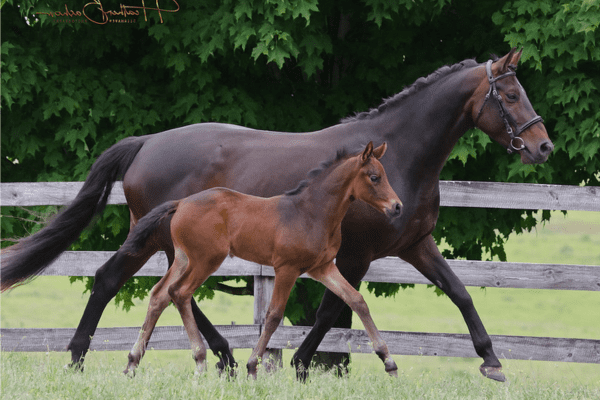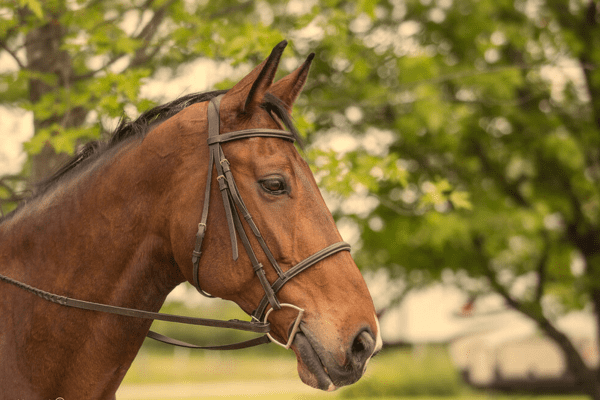The Oldenburg, often referred to as the Oldenburger, is a prestigious warmblood breed hailing from the northwestern region of Lower Saxony, Germany. Its roots can be traced back to robust and versatile farm and carriage horses, known historically as the Alt-Oldenburger.
Today’s Oldenburg horse has evolved under the careful stewardship of the Association of Breeders of the Oldenburger Horse, a body dedicated to preserving and enhancing the breed’s renowned qualities. This evolution has seen the Oldenburg transform from a multifunctional workhorse into a refined, high-performance sport horse, while maintaining its noble and versatile lineage.
History:
The Oldenburg horse is a majestic horse, with its impressive stature and rich heritage, is a testimony to the centuries of thoughtful and skilled breeding. The transformation of this horse from a workhorse of the region to an ultra-modern sport horse tells a tale of innovation, adaptation and a long-lasting legacy.
Early Beginnings:
Pre-17th Century Roots: The Oldenburg region the early stock of horses was robust, yet small, and bred to meet the rigors of working on the Frisian coast’s hard soil. These horses formed the basis for the breeding.
Count Johann XVI’s Impact (1540-1603 ): A pivotal figure, Johann XVI infused the local horse population with the most superior breeds, such as Frederiksborgers from Denmark and sophisticated Turkish horses, as well as the formidable Neapolitan as well as Andalusian horses, enhancing the status of the breed.
Continued Development:
Count Anton Gunther’s Era (1583-1667 ): Succeeding Johann XVI. Anton Gunther augmented the breed by acquiring exceptional horses during his travels, expanding the genetic pool as well as improving the characteristics of the breed.
Rigorous Inspection Regulations: In 1715 in Ostfrisia as well as later in Oldenburg in 1755, rigorous horse inspections were introduced and became mandatory in 1820. The meticulous selection process quickly adjusted the breed to the market requirements.
Transformation into Luxury Horses
Evolving Roles: Originally essential as carriage and farm horses The Oldenburg as well as the Ostfriesen breeds evolved into luxurious horses, renowned by their fashionable carriage and gait with high-stepping, while maintaining their usefulness for farm work.
Unique Breeding Freedom:The absence of an equine stud farm owned by the state in Oldenburg provided private breeders with more choice in choosing their breeding stock, thus facilitating the spread of the breed.
Shift to Recreational Riding:
Post-WWII Changes: With the rise of mechanization during the 1950s, 1940s the traditional tasks that were played by the Oldenburg were replaced. Additionally, an increase in entertainment and income sparked the interest in riding for recreation.
Unique Breeding Freedom: The Oldenburg breeders mastered the art of creating top-quality riding horses making use of their history of producing extraordinary carriage horses.
Incorporation of Foreign Bloodlines:
Condor’s Arrival: The arrival of Condor the stallion from Anglo-Norman was the first step in the integration of bloodlines from other countries to improve the riding abilities of the breed.
Contributions of diverse stallion breeds:Later imports included thoroughbreds such as Adonisxx and others, along with French sires, as well as Trakehners with new characteristics and enhancing the athletic capabilities of the breed.
Technological Advancements:
Artificial Insemination Impact Since the 1970s onward, advances in artificial insemination widened the range of genetic diversity available breeders, and included horses from all over Europe.
Global Genetic Influence: The result was the introduction of a variety of Warmbloods in addition to Selle Francais continuously making the Oldenburg.
The German Oldenburg Verband:
Quality-Centric Methodology: The Verband’s approach that emphasizes quality over color or pedigree has allowed the Oldenburg to be a top dressage horse and jumping.
Broad Studbook Representation: The Oldenburg Association oversees a vast range of approved sires as well as mares, as well as an international program that focuses on show jumping, which makes one of Germany’s largest Studbooks.
Showcasing Excellence:
Annual Events: “Stallion Days” in Vechta are a major event, during which young stallions are evaluated and”Old Stallion Parade “Old Stallion Parade” showcases tested, approved stallions.
Auctions and Competitions: The horse’s ability to compete is also displayed through auctions, as well as jump competitions that are free for young horses.
Emphasis on Mare Lines:
Elite Broodmare Show: The Verband is a major focus on the mare’s lines, with many that trace their origins all the way back to Alt-Oldenburg. This Elite Broodmare Show in Rastede is a highly regarded event where top young mares compete for the top honors, demonstrating the breed’s modern and historic characteristics.
The Oldenburg horse’s transformation from a local workhorse into an elite sports horse is a reflection of the ever-changing expectations and needs of horsemen over the decades. Its tale is one of perseverance as well as adaptability and a constant determination to excel, cementing its place as a symbol within the world of horses.


Characteristics:
Oldenburg horse Oldenburg horse, revered in equestrian circles due to its elegance and versatility, is adorned with numerous distinctive features which highlight its status within the realm of sport horses.
Brand and Identification:
One of the hallmarks characteristic of Oldenburg breeds is the distinctive brand. Oldenburg breed is the distinctive branding that represents their tradition. The brand, which is with an “O” crowned with a elegant emblem, is typically located at the right hip. For horses that are part of the “Oldenburg International” program, the brand has the letter “S” within a crowned partially finished “O”.
Additionally, the last number of the horse’s lifetime number are displayed under the brand, which is only for Oldenburgs less than two years old. Modern identification techniques also include an electronic microchip embedded in the crest of the neck, which ensures exact identification.
Physical Characteristics:
This Oldenburg horse is famous for its distinctive appearance, frequently referred to as modern within the warmblood category. The Oldenburg horses usually have an expressive head and especially long legs.
For physical appearance, they adhere to the model of a sport horse that is characterized by a built that is uphill with a neck that is fairly elongated and an extended, slightly tilted pelvis. The standard height of the breed is from 16 to 17.2 hands (64 and 70 inches 163 and 178cm) and displays a mix of power and grace.
Coat Colors:
With a variety of coat shades The Oldenburg breed is renowned for its unique warmblood hues. Particularly, in areas like in the United States and Germany, the breed is characterized by a variety of tobiano stallions. Most coat colors are brown, black bay, chestnut and grey, indicating the variety of genetic heritage that this breed has.
Gait and Movement:
Oldenburg horses are renowned for their lively and flexible gaits, characterized by a substantial suspension. While the individual characteristics of each gait differ, they’re all ideal for equestrian activities.
These horses exhibit smooth, rhythmic walks, canters and trots with each one having distinct features such as the wide walk and dependable while the trot is lively and flexible and the trot fluid and flexible.
The breed’s abilities extend to jumping, in which Oldenburgs who are dressage-focused show exceptional ability.
Temperament and Performance Suitability:
In an age where horse breeds that are autonomous and sensitive are becoming more sought-after in show arenas that are competitive, like jumping The Oldenburg breed combines these qualities with the ability to be used by amateur riders.
This is evident in the performance tests of the breed that evaluate traits like character, temperament, constitution and work ethic in addition to riding ability. Oldenburg Verband Oldenburg Verband thereby equips breeders with the ability to select either professional sports or more casual temperaments, offering a wide range of choices in the breeding.
Breeding and Naming Practices:
The Oldenburg breed is distinguished by its name convention. The colt name is patrilineally having the same initial letter as their sire’s initials, whereas the fillies’ names are matrilineally following the initial letter of their dam’s name. This method of name-shopping helps in the tracing of lineages and bolsters the breed’s rich heritage.
Oldenburg Horse: Triumphs and Transformation in Equestrian Sports
This Oldenburg horse, famous for its agility and versatility has a long history of success in different disciplines of equestrian. The journey of this breed through show jumping, eventing and dressage demonstrates its ability to adapt and the skilled breeding process that has led it to world-wide acclaim.
Eventing Prowess:
Removing Stereotypes: Contrary the notion that Oldenburgers, unless they are sired by the bloodline of a Thoroughbred breed, are slow for eventing, this breed has proven to be a great performer in this sport.
WBFSH Rankings The Oldenburg Verband achieved the 11th spot on the World Breeding Federation for Sport Horses events rankings and its strong presence in the world arena.
Historical Achievements: One testimony to the breed’s ability in the arena was Volturno Black Stallion, born in the year 1968. Volturno was not just an Olympian but also a major part from the 1996 German Olympic team that secured an Olympic silver medal.
Show Jumping Success:
The Oldenburg Jumper Studbook: The introduction of the Oldenburg Jumper Studbook in 2001 was a pivotal moment that heightened the focus of the breed on and performance at show jumping.
Breeding for excellence: Oldenburg horses are selectively breed for the most important traits for show jumping such as confidence, prudence, strength and aplomb over fences.
Worldwide Recognition. The breed’s performance in this area is highlighted by its position at #7 on the WBFSH show jumping rankings. Notable champions such as the 2006 World Cup winner Sandro Boy and Arko III, who have boosted its standing.
Dominance in Dressage:
The Legacy of Sires: The Oldenburg’s rise in dressage can be attributable to powerful sires such as Donnerhall as well Sandro Hit who have played an integral role in the breeding of top dressage horses.
WBFSH Standings in 2006 Oldenburgers placed third in dressage, which is a impressive feat considering the fierce competition from breeds such as that of Hanoverian as well as Dutch Warmblood.
Olympic level performance: This breed’s ability in dressage isn’t just limited to rankings, but it can also be seen in the most famous arenas, such as the Olympics.
In short it is clear that the Oldenburg horse’s growth in horse racing is a tale of breaking down stereotypes and reaching new heights with the help of committed breedering and training. From their impressive events, despite misperceptions about their speed, their well-known performance in show jumping and their dominance on dressage.
Oldenburg horses are constantly demonstrated their skills in the world of equestrian. This breed’s history is not only one of success but also one of change in which they have adapted and improved with the many demands of equestrian sport.


Preservation:
The breeding and preservation of Oldenburg horses is managed through The Oldenburg Verband, which maintains strict standards to guarantee the authenticity and quality that the horse breed has. This dedication to excellence has allowed the Oldenburg keep its status as one of the most prestigious sport horse breeds.
As a breed as a breed, the Oldenburg horse is an ideal combination of beauty, strength and the ability to think. Their long-standing significance, combined with their current achievements in equestrian sports, make them an absolute gem in the equestrian world. In the show ring, in the dressage arena, or just as a reliable companion the Oldenburg horse is still in the hearts of lovers of horses all over the world.

